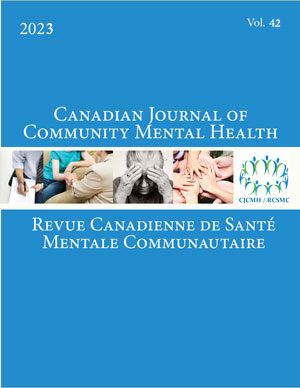Volume 22 • Number 2 • September 2003
OPEN ACCESS
Two-hundred and twenty participants recruited through multiple sampling strategies completed a self-report questionnaire examining: (a) whether internalized homophobia predicts depressive and anxious symptoms, suicide, and substance abuse; and (b) the periods of gay-identity development which were particularly risky for suicide. Results indicate that internalized homophobia, particularly negative feelings towards one's own homosexuality (as measured by the Self subscale of the Nungesser Homosexual Attitudes Inventory), accounts for 18% of the variance in depressive scores and 13% of anxiety scores (using the Beck inventories). Internalized homophobia did not predict suicide independently from depression. The period of greatest risk for both suicidal ideation and suicide attempts was the period of disclosure of one's homosexuality to one's immediate family.
OPEN ACCESS
Adult lesbian survivers of childood sexual abuse were interviewed using grounded and structured methods to explore the interaction between being, or coming out as, a lesbian and healing from childhood sexual abuse (CSA). A history of CSA was found to render coming out as a lesbian more complicated and often more difficult. Having or developing a lesbian identity caused significant changes in respondents' social support networks and spiritual beliefs and communities, afforded many opportunities for greater healing, and in the balance seemed to facilitate the healing process. Implications for program planning and service delivery are briefly discussed.
OPEN ACCESS
Using a subset of youth from a sample of 3,636 Canadian adolescents, the present study examined sexual orientation and victimization experiences in high school. A total of 130 adolescents indicated they were gay, lesbian, bisexual, or questioning their sexual orientation. Significantly more adolescents identified as bisexual (N = 50) or questioning (N = 68) than as gay or lesbian (N = 12). Sexual-minority and questioning youth were more likely than heterosexual youth to be victims of bullying, peer sexual harassment, and peer or dating-partner physical abuse. Implications of victimization on questioning and sexual-minority adolescents' mental health are discussed.
OPEN ACCESS
Concerns still exist among lesbian-, gay-, bisexual-, transgendered-, and queer-identified individuals (LGBTQ individuals) about their reception and treatment by psychiatric service providers. The Psychiatric Service at the University of Toronto and the Office of LGBTQ Resources and Programs convened a committee to address expanding the capacities of the Service related to the needs of LGBTQ and questioning students. In this paper, we describe the committee's role, initiatives, and successes and discuss challenges encountered in the process. The model of community development drawn from in this work can be adapted for use in other community health settings.
OPEN ACCESS
This article examines the question of how universities can be encouraged to address the mental health concerns of GLBT-SQ people and communities from a perspective of solidarity. In so doing, the authors take a case study approach, using Project Interaction: The Gay, Lesbian, Bisexual and Two-Spirit Initiative of McGill University's School of Social Work, to critically reflect upon the challenges arising from the development of an alternative organization within academia. The purpose of this reflection is to highlight how normal operations at work on university campuses, and within health and allied health curriculum, can be disrupted with the goal of providing momentum for the creation of affirmative space, the advancement of educational initiatives, and the building of opportunities for social change.
OPEN ACCESS
L'invisibilité sociale des lesbiennes âgées constitue un obstacle de taille à l'adaptation des services résidentiels à leurs besoins. Après un examen des difficultés associées au vieillissement chez les lesbiennes, cet article explore quelques mécanismes sociaux qui reproduisent cette invisibilité à partir d'entrevues avec 10 intervenants et intervenantes dans des résidences pour le troisième âge et avec 10 lesbiennes âgées vivant à domicile. Chez ceux et celles qui fournissent des services, l'on constate une ouverture sur le plan des attitudes individuelles, conjuguée à une méconnaissance des réalités psychosociales des lesbiennes âgées et à un attentisme au niveau de la gestion des établissements. De leur côté, les lesbiennes interviewées perçoivent les résidences comme des environnements trop peu sécuritaires pour y affirmer leur orientation sexuelle.
OPEN ACCESS
This study used a qualitative research design to explore hospital policies and practices and the assumption of female heterosexuality. The assumption of heterosexuality is a product of discursive practices that normalize heterosexuality and individualize lesbian sexual identities. Literature indicates that the assumption of female heterosexuality is implicated in both the invisibility and marked visibility of lesbians as service users. This research adds to existing literature by shifting the focus of study from individual to organizational practices and, in so doing, seeks to uncover hidden truths, explore the functional power of language, and allow for the discovery of what we know and—equally as important—how we know.
OPEN ACCESS
La violence conjugale chez les gais et les lesbiennes est un champs de pratique et d'études en émergence. Le Groupe d'intervention en violence conjugale chez les lesbiennes (GIVCL) est le premier groupe francophone québécois à intervenir auprès des lesbiennes victimes de violence conjugale. Créé à partir d'un constat de manque d'aide et de ressources facilement accessibles et adaptées aux lesbiennes, le GIVCL offre des groupes de soutien structurés aux victimes de violence conjugale, des sessions de formation et d'information sur la question et participe à la recherche dans ce domaine. Cet article présente le programme d'intervention du GIVCL, discute des limites du programme et propose des pistes qui pourraient favoriser le développement de services encore mieux adaptés aux besoins de la communauté lesbienne.










